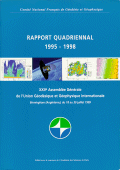 |
Interférométrie radar appliquée aux volcans: cas de l’Etna et des Champs Phlégréens (Italie)
Pierre Briole, Antonio Avallone, François Beauducel, Alessandro Bonforte, Valérie Cayol, Christine Deplus, Christophe Delacourt, Jean-Luc Froger, Barbara Malengreau, et Giuseppe Puglisi
Rapport Quadriennal CNFGG 1995-1998, 121-128, presented at Union Internationale de Géodésie et Géophysique, Birmingham, 1999.
|
Abstract.
During the last few years, the radar images collected by the European satellites ERS1 and ERS2, the Japanese satellite JERS and the Canadian satellite RADARSAT have been used with success to create interferograms. This technique has been applied for geophysical applicati ons like co-seismic deformation mapping, volcano deformation monitoring, landslides monitoring, mining subsidence detection, glaciers monitoring. Here we report the research carried out by our group on Etna volcano (Italy) and in the area of Naples (Italy) where are located several potentially active volcanoes (Vesuvius, Ischia) and where a subsidence of the caldera of Campi Flegrei is still on going in response to the 1982-1984 seismic crisis. Etna is the volcano that has been studied first using ERS SAR interferometry. Using this method, a large scale deflation of the volcano associ ated wi th the large 1991-1993 eruption was detected in data covering the second half of the eruption. Further studies showed that the local deformation fields located in Valle del Bove (East of the volcano) where associated with the compaction of the 1986-1987 and 1989 lava fields and also partly with a subsidence of the surrounding terrain in response to the load of the new deposited material. Other local deformation fields have been identified, corresponding to the 1983, 1981 and 1971 lava fields. However, due to its strong topography, interferograms of Etna are affected by tropospheric effects. Those effects must be eliminated in order to correctly interpret the fringes pattern. The problem of the troposphere has been first investigated from its theoretical point of view and using existing local meteorological data as well as radio-soundings data. Recently, thanks to the large amount of available interferograms, another approach has been investigated, consisting in the research of a correlation fringe/elevation in the interferograms themselves. This approach, operated either in automatic mode (automatic fringe unwrapping) or in manual mode proved to be efficient for most of the coherent interferograms. After removal of the tropospheric correction, the evolution of the deformation of the volcano at large scale between 1992 and 1998 has been inferred. The subsidence occurring during the second half of the 1992 eruption as well as the uplift preceding the 1995 unrest of the Southeast crater are visible, but their amplitude is less than previously estimated. The depth of the modelled source of subsidence/uplift related to the l arge scale deformation is of the order of 6 to 8 km, not well constrained by the data. The study of the correlation fringe/elevation was possible only after a detailed analysis of the spatial and temporal properti es of coherence of the Etna area. Indeed, the technique of fringe unwrapping for fringe/elevation correlation analysis is possible only if the poorly coherent pixels are eliminated. A map of the most coherent pixels of the volcano was produced. The recent lava fields as well as the towns and villages surrounding the volcano are the most coherent areas. The quality of the interferograms is also enhanced when high accuracy DEM (Digital Elevation Model) are used. Using kinematic GPS data collected along more than 100 km of road around the volcano, we assessed the accuracy of several DEMs of Etna. The most accurate DEM was produced by digitising 1/25.000e maps of Etna. This DEM does not take into account the topographic changes due to the recent eruptions. Merging other more recent DEMs corresponding to those areas, we produced an updated relatively high accuracy DEM (±3 m) of Etna. In the Naples area, we analysed interferograms in the period 1993-1996 and show that the Campi Flegrei caldera is still subsiding at a rate of about 30 mm/year.
Read the complete HTML article (in French) or download the PDF file: 
See also related publications: [Beauducel et al., 1999; Avallone et al., 1999; Briole et al., 1999]
